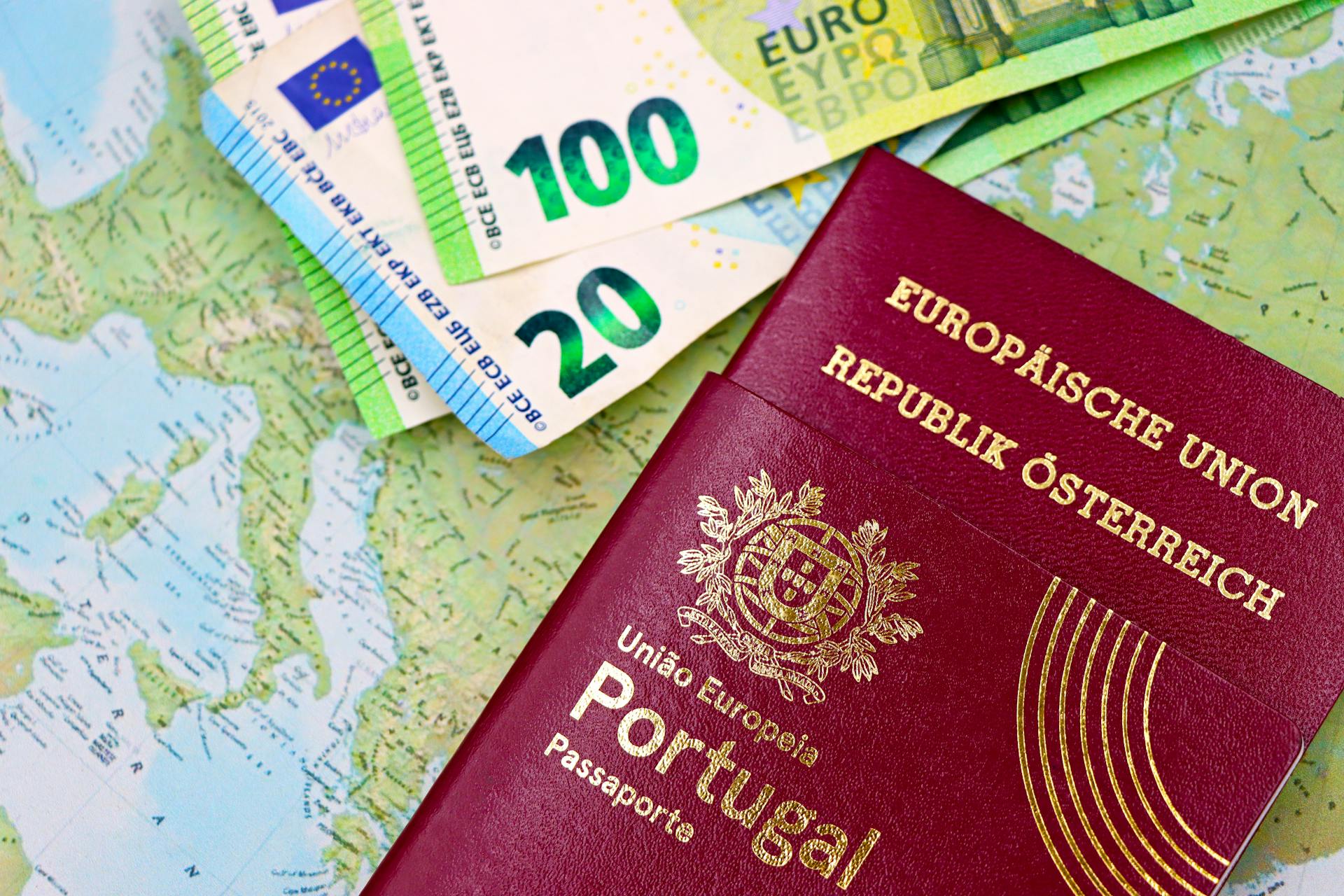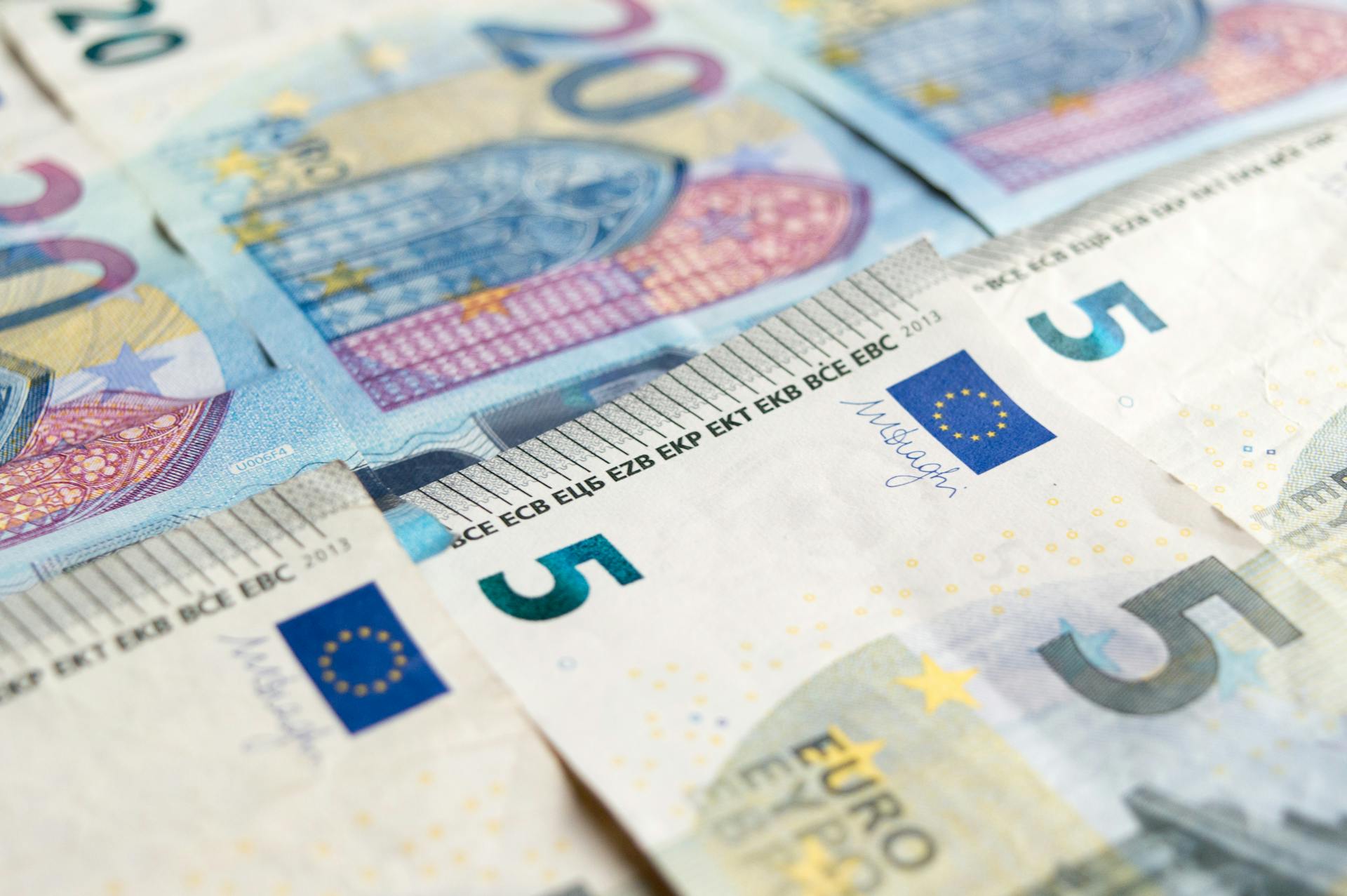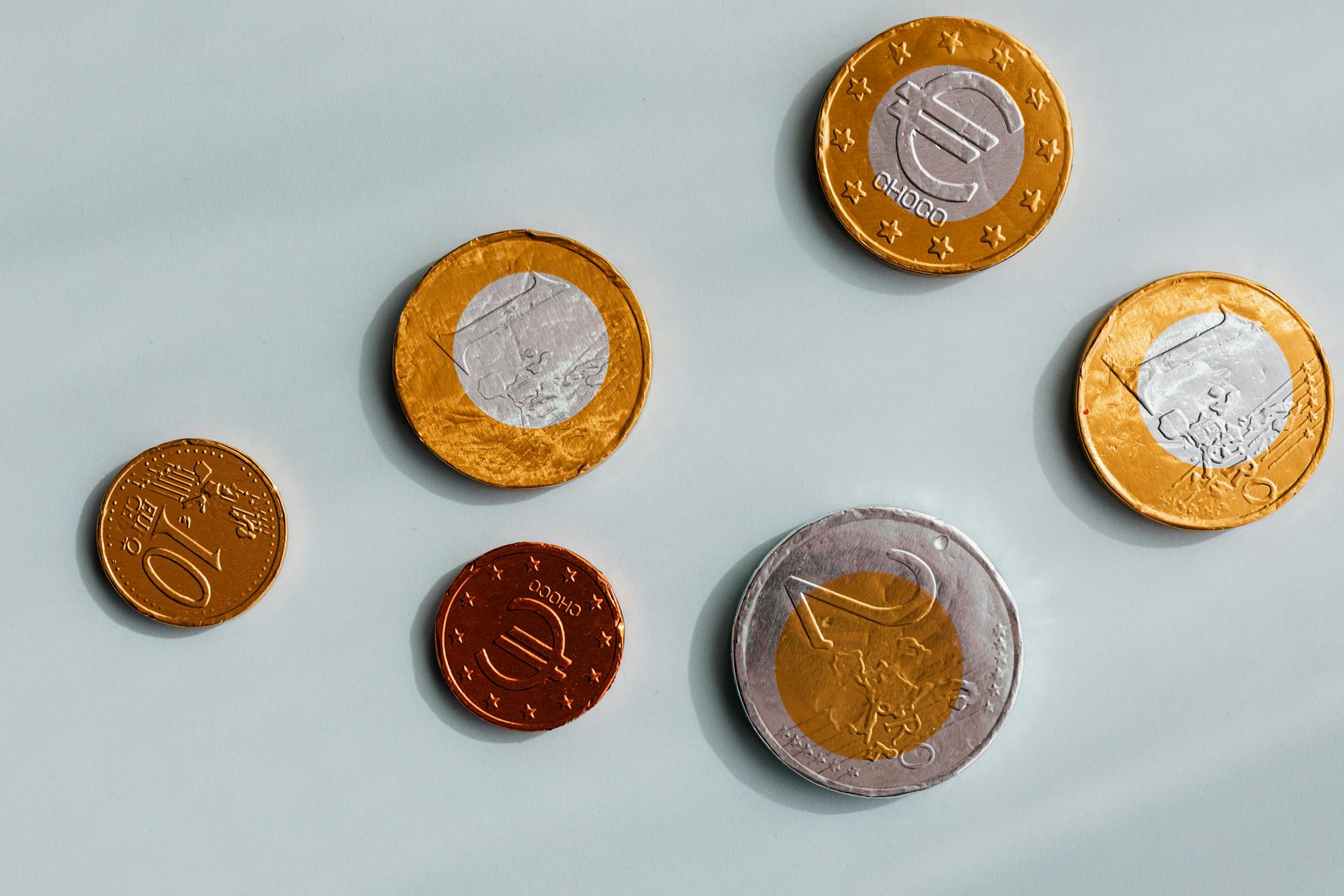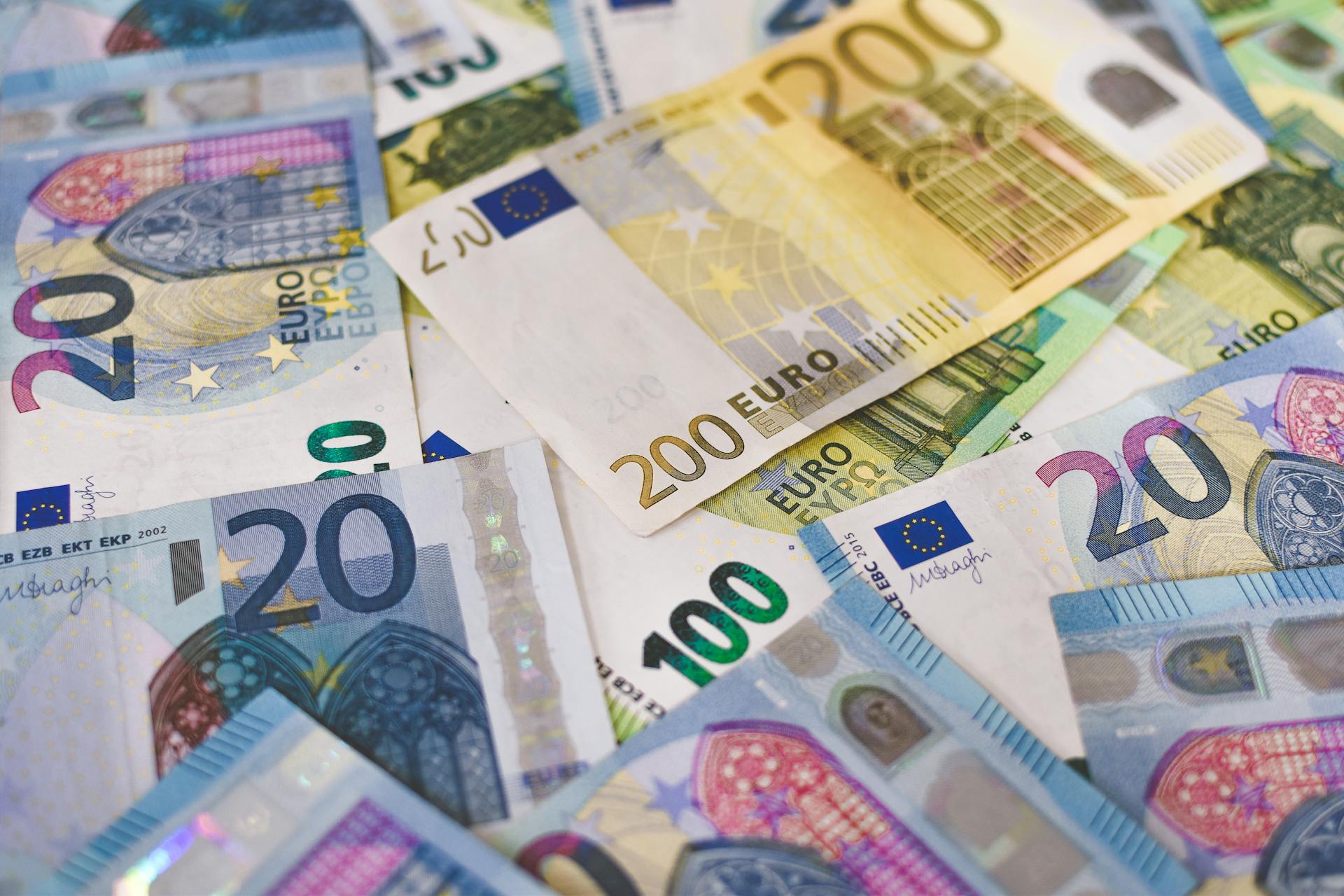
The European Monetary System (EMS) has a rich history that laid the groundwork for the modern European economy. The EMS was established in 1979 to promote economic stability and cooperation among European countries.
One of the key milestones in EMS history was the creation of the European Currency Unit (ECU), a basket of European currencies that served as a precursor to the euro. The ECU was introduced in 1979 and was used as a unit of account for EMS transactions.
In the early years of the EMS, member countries worked to reduce their exchange rate volatility and achieve economic convergence. This involved implementing policies to control inflation and balance their budgets.
The EMS was also marked by the creation of the Exchange Rate Mechanism (ERM), which allowed member countries to peg their exchange rates to the ECU within narrow margins. This helped to reduce exchange rate fluctuations and promote economic stability.
Broaden your view: Foreign Exchange Rate Management
History
The European Monetary System (EMS) was created in 1978, when French President Valéry Giscard d'Estaing and German Chancellor Helmut Schmidt successfully championed it at a meeting of the EEC in Brussels.

The EMS officially entered into force on 13 March 1979 with the participation of eight Member States, including France, Denmark, Belgium, Luxembourg, Ireland, Netherlands, Germany, and Italy.
The EMS was launched in response to the abandonment of the Bretton Woods System in 1971, which had been used to maintain stability among major currencies since the Second World War.
The EMS introduced the European Currency Unit and the European Exchange Rate Mechanism to achieve monetary stability and work towards a single market in Europe.
The EMS was marked by early years of adjustments and uneven currency values, which raised the stronger currencies' values and lowered the values of the weaker ones.
In 1972, the EEC countries pegged their currencies to each other in a scheme known as the snake in the tunnel, based on the Werner Report's recommendations.
Italy left the snake in 1973, and the EMS continued to face challenges, including the varying political and economic conditions of its member countries.
The EMS was in crisis in the early 1990s, with Britain permanently withdrawing from the arrangement and Germany's unification causing economic strain.

The Maastricht Treaty, signed in 1993, marked a significant step towards forming greater economic alliances and establishing a common currency.
The European Monetary Institute was established in 1994, and later became the European Central Bank (ECB) in 1998, with the responsibility of instituting a single interest rate and monetary policy.
By the end of the 1990s, most EU countries had cut their interest rates simultaneously to promote economic growth and prepare for the introduction of the Euro.
Key Features and Principles
The European Monetary System (EMS) had two distinct phases.
In the first period, from 1979 to 1986, member countries were allowed a certain degree of autonomy in monetary policy by restricting the movement of capital.
The EMS became more rigid in the second period, from 1987 to 1992.
Core Features of EMS
The European Monetary System (EMS) had its fair share of complexities, but let's break down its core features.
Fixed exchange rates were a key component of the EMS, but it became evident in the 1992 crisis that this system affected different economies in different ways.
One of the main issues with fixed exchange rates was that they were not beneficial to all economies.
See what others are reading: European Exchange Rate Mechanism
Changing Operating Principles for Euro Preparation

The EMS went through two distinct phases before preparing for the Euro.
During the first period, from 1979 to 1986, the EMS allowed member countries a certain degree of autonomy in monetary policy by restricting the capital movement.
In 1987, the EMS became more rigid, marking the beginning of a new phase.
A committee was set up under EEC President Jacques Delors in 1988 to change the EMS and prepare it for the transition to Economic and Monetary Union (EMU).
The Delors plan was a three-stage process that led to a single European currency under the control of a European Central Bank.
German Policy and Dominance
The European Monetary System, or EMS, was heavily influenced by German monetary policy. German policy dominated the EMS because it pegged member currencies within a fluctuation band, similar to the Bretton Woods system.
The EMS effectively centered on the Deutsche Mark, which was the anchor of the system, despite no currency being officially designated as such. This led to a power imbalance within the EMS.

Germany's strong growth rate and low-inflation policies made its central bank the anchor of the EMS. The Deutsche Mark's influence dictated the policy of the European Monetary System.
The EMS was also affected by the influence of the US dollar, causing strong disturbances within the system. This ultimately led to dissatisfaction in most countries, driving the push for a monetary union.
Criticism
The European Monetary System (EMS) faced significant criticism during its early years. Michael J Artis (1987) noted that the EMS had low credibility during its first eight years.
One of the main criticisms was that the EMS failed to achieve long-term stability in real exchange rates. Real exchange rates are crucial for investment, output, export, and import decisions, but the EMS only succeeded in reducing short-term changes in bilateral exchange rates and nominal exchange rates.
Inflation rates continued to differ widely among EEC countries, with Germany experiencing a 3 percent inflation rate and Italy's inflation rate reaching 13 percent. This lack of convergence was a major issue.

Nominal and real interest rates increased substantially after 1979, and the EMS provided little benefit to its members in terms of monetary and financial stability. This was a major setback for the system.
The EMS also faced criticism for being a de facto Deutsche Mark zone, with Axel A. Weber (1991) claiming that it was often called “tying one's hands” because of the fixed exchange rate policy. This policy had short-run effects, but it limited the flexibility of the other member countries.
The smaller EMS economies, such as Belgium, Denmark, and Ireland, had short-term credibility but lacked long-term credibility. In contrast, Germany and the Netherlands had the most long-term credibility due to their low inflation records.
Objectives
The European Monetary System had several key objectives. One of the main goals was to foster trade within Europe.
To achieve this, the EMS aimed to encourage trade among its member countries. This was a crucial step in promoting economic unity across Europe.

The EMS also sought to control inflation within Europe. This was essential for maintaining economic stability and preventing economic downturns.
Another important objective was to stabilize the exchange rate among the trading members. This helped to reduce uncertainty and promote economic cooperation among the member countries.
Here are the main objectives of the EMS in a concise list:
- Fostering trade within Europe
- Controlling inflation within Europe
- Stabilizing the exchange rate among the trading members
Benefits and Stability
The European Monetary System provided several benefits, particularly in terms of stability. The EMS ensured currency stability in Europe during times of international market volatility.
One of the key advantages of the EMS was its ability to maintain exchange rate stability among member countries. This stability was a major factor in promoting economic growth and cooperation among European nations.
The EMS played a crucial role in reducing transaction costs and increasing economic efficiency. By eliminating the need for frequent exchange rate adjustments, businesses and individuals could engage in international trade with greater ease and confidence.
Intriguing read: International Monetary Standard

The EMS also helped to reduce the risk of currency fluctuations, which in turn reduced the risk of economic instability. This stability helped to create a favorable business environment and encouraged investment in the region.
The EMS's emphasis on currency stability had a positive impact on the European economy, helping to promote economic growth and cooperation among member countries.
Here's an interesting read: Systemic Risk
What Is
The European Monetary System was established in 1979 to promote economic stability and cooperation among European countries. It was a response to the economic crises of the 1970s, which highlighted the need for a more coordinated monetary policy.
The system aimed to reduce exchange rate fluctuations and promote economic convergence among member countries. The European Monetary System was not a single currency area, but rather a framework for cooperation among countries with their own currencies.
The European Monetary System had two main pillars: the Exchange Rate Mechanism (ERM) and the European Monetary Fund (EMF). The ERM allowed countries to fix their exchange rates within a narrow band, while the EMF provided a mechanism for crisis management and economic support.
The European Monetary System was a significant step towards economic integration in Europe, but it had its limitations. It was not a precursor to a single currency, but rather a way to stabilize exchange rates and promote economic cooperation among member countries.
Crisis and Challenges

The European Monetary System faced a major crisis in 1992, which was triggered by Germany's decision to raise its interest rates to combat inflation. This move put upward pressure on the exchange rates of member countries, many of which needed low interest rates and higher exports to thrive.
The crisis was further exacerbated by the differing economic policies and conditions of the member countries, including the newly reunified Germany and Britain, which had initially declined to join the EMS. The crisis led to a series of events, including speculative attacks on the French franc and large capital outflows from the UK and Italy.
The crisis ultimately led to the withdrawal of Italy and the UK from the European Exchange Rate Mechanism (ERM) in September 1992. The ERM was a key component of the EMS, and its collapse had significant implications for the stability of the European economy.
Here are the three primary reasons for the 1992 crisis, as identified by Barry Eichengreen:
- Inadequate harmonization of past policies, which contributed to competitive imbalances among member countries.
- Inadequate harmonization of future policies, which reduced the credibility of governments with high unemployment rates and weak public support.
- Speculative pressures, which were fueled by the Maastricht Treaty's conditions for self-fulfilling speculative attacks.
Crisis of 1992
The Crisis of 1992 was a pivotal moment in European economic history. It was triggered by Germany's decision to raise interest rates to combat inflation.
This move put upward pressure on the exchange rates of member countries, which were struggling to stay competitive. The crisis was further exacerbated by the differing economic policies and conditions of its members.
The EMS was strained by the crisis, with many countries experiencing turmoil and ultimately eliminating their pegging system with the ECU. This allowed exchange rates to float, giving countries more flexibility to respond to economic changes.
The crisis led to a significant change in the EMS, with the bandwidth for exchange rate volatility being broadened from +/-2.25% to +/-15%. This gave countries more room to maneuver and reduced the risk of speculative attacks.
Here are the three primary reasons for the crisis, according to Barry Eichengreen:
- Inadequate harmonization of past policies: Italy, Spain, and the UK had not brought their inflation rates down to the levels of other EMS members.
- Inadequate harmonization of future policies: rising unemployment reduced the credibility of governments with high unemployment rates and weak public support.
- Speculative pressures: the Maastricht Treaty provided the conditions for self-fulfilling speculative attacks.
What Was the Process?
The European Monetary System had a strict process in place to manage exchange rates.

Exchange rates were allowed to deviate within a certain range from the fixed central point, which was determined by the ECU and the European Economic Community.
The fixed central point was the benchmark for all member countries' currencies.
Exchange rate fluctuations were limited to 2.25% from the fixed central point.
This narrow margin made it difficult for member countries to make significant adjustments to their exchange rates.
The ECU played a crucial role in determining the fixed central point, which in turn influenced the exchange rates of member countries.
A different take: European System of Central Banks
Explaining EMS
The European Monetary System (EMS) was created in 1978, implemented via resolution at a meeting of the EEC in Brussels on 5 December 1978, championed by French President Valéry Giscard d'Estaing and German Chancellor Helmut Schmidt.
The EMS officially entered into force on 13 March 1979 with the participation of eight Member States, including France, Denmark, Belgium, Luxembourg, Ireland, Netherlands, Germany, and Italy.

The EMS was established in response to the collapse of the Bretton Wood Agreement, which led to significant fluctuations in currency market values.
The EMS had some key features, including the European Currency Unit (ECU), which was the monetary unit used in transactions involving the EC.
The Exchange Rate Mechanism (ERM) was also a key part of the EMS, allowing participating member states to agree on maintaining currency fluctuations within specific limits.
The European Monetary Corporation Fund issued ECU and supervised the ERM.
Here are the key features of the EMS:
- European Currency Unit: It was the monetary unit utilized in transactions involving the EC.
- Exchange Rate Mechanism: Also known as ERM, it is the mechanism by which participating member states reach an agreement to maintain the fluctuations concerning currency within specific limits.
- European Monetary Corporation Fund: A fund that issued ECU and supervised the ERM.
Frequently Asked Questions
What is the snake European Monetary System?
The Snake European Monetary System allowed Member States' currencies to fluctuate within a narrow 2.25% margin against the US dollar. This mechanism enabled central banks to buy and sell European currencies within these limits.
Sources
- https://en.wikipedia.org/wiki/European_Monetary_System
- https://corporatefinanceinstitute.com/resources/economics/european-monetary-system-ems/
- https://www.elibrary.imf.org/view/book/9781557750631/C1.xml
- https://www.wallstreetmojo.com/european-monetary-system/
- https://www.cambridge.org/core/books/european-monetary-system/CD189E6B60E8DDD136C4D958B591CC10
Featured Images: pexels.com

